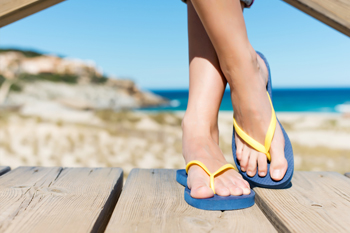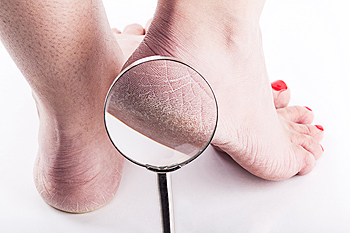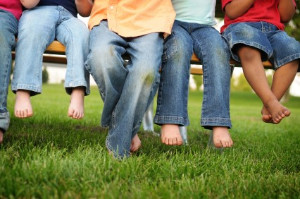Items filtered by date: April 2020
Feet May Change Shape During Pregnancy
 The growing fetus and hormonal changes are among the top reasons many pregnant women notice their feet becoming tired and swollen. The weight that is gained may cause the foot structure to change, and larger shoes may have to be purchased to accommodate this change. The arch in the feet can become flat, which may occur as a result of relaxed ligaments. It may become difficult to trim the toenails in advanced pregnancy, and it is suggested that a family member help you to maintain daily foot care. There are some pregnant women who notice warts on the bottom of the feet. These are referred to as verruca, and may cause pain and discomfort. It is considered to be a contagious virus, and medical advice may be needed from a podiatrist who can help you to treat this condition.
The growing fetus and hormonal changes are among the top reasons many pregnant women notice their feet becoming tired and swollen. The weight that is gained may cause the foot structure to change, and larger shoes may have to be purchased to accommodate this change. The arch in the feet can become flat, which may occur as a result of relaxed ligaments. It may become difficult to trim the toenails in advanced pregnancy, and it is suggested that a family member help you to maintain daily foot care. There are some pregnant women who notice warts on the bottom of the feet. These are referred to as verruca, and may cause pain and discomfort. It is considered to be a contagious virus, and medical advice may be needed from a podiatrist who can help you to treat this condition.
Pregnant women with swollen feet can be treated with a variety of different methods that are readily available. For more information about other cures for swollen feet during pregnancy, consult with Dr. John P. Beaupied from Palos Podiatry. Our doctor will attend to all of your foot and ankle needs.
What Foot Problems Can Arise During Pregnancy?
One problem that can occur is overpronation, which occurs when the arch of the foot flattens and tends to roll inward. This can cause pain and discomfort in your heels while you’re walking or even just standing up, trying to support your baby.
Another problem is edema, or swelling in the extremities. This often affects the feet during pregnancy but tends to occur in the later stages.
How Can I Keep My Feet Healthy During Pregnancy?
- Wearing orthotics can provide extra support for the feet and help distribute weight evenly
- Minimize the amount of time spent walking barefoot
- Wear shoes with good arch support
- Wear shoes that allow for good circulation to the feet
- Elevate feet if you experience swelling
- Massage your feet
- Get regular, light exercise, such as walking, to promote blood circulation to the feet
If you have any questions please feel free to contact our office located in Palos Heights, IL . We offer the newest diagnostic and treatment technologies for all your foot and ankle needs.
Is It Ok to Wear Flip Flops?
 Flip flops have become a popular type of shoe to wear during the warmer months of the year. They are easy to wear, and are designed in a variety of colors and materials. Many people choose to wear flip flops despite the foot conditions they may cause. These can consist of pain in the heel and arch areas, which may be a result of a lack of support the thin soles generally provide. Additionally, the toes are exposed, and many people may stub them, or have heavy objects fall on them. Blisters may form between the toes in a grasping effort to keep the shoes on the feet. If you would like more information about how flip flops affect the feet, please consult with a podiatrist.
Flip flops have become a popular type of shoe to wear during the warmer months of the year. They are easy to wear, and are designed in a variety of colors and materials. Many people choose to wear flip flops despite the foot conditions they may cause. These can consist of pain in the heel and arch areas, which may be a result of a lack of support the thin soles generally provide. Additionally, the toes are exposed, and many people may stub them, or have heavy objects fall on them. Blisters may form between the toes in a grasping effort to keep the shoes on the feet. If you would like more information about how flip flops affect the feet, please consult with a podiatrist.
Flip-flops can cause a lot of problems for your feet. If you have any concerns about your feet or ankles, contact Dr. John P. Beaupied from Palos Podiatry. Our doctor will assist you with all of your foot and ankle needs.
Flip-Flops and Feet
Flip-flops have managed to become a summer essential for a lot of people. While the shoes may be stylish and easy to slip on and off, they can be dangerous to those who wear them too often. These shoes might protect you from fungal infections such as athlete’s foot, but they can also give you foot pain and sprained ankles if you trip while wearing them.
When Are They Okay to Wear?
Flip-flops should only be worn for very short periods of time. They can help protect your feet in places that are crawling with fungi, such as gym locker rooms. Athlete’s foot and plantar warts are two common fungi that flip-flops may help protect your feet against.
Why Are They Bad for My Feet?
These shoes do not offer any arch support, so they are not ideal for everyday use. They also do not provide shock absorption or heel cushioning which can be problematic for your feet. Additionally, you may suffer from glass cuts, puncture wounds, and stubbed toes since they offer little protection for your feet.
More Reasons Why They Are Bad for Your Feet
- They Slow You Down
- May Cause Blisters and Calluses
- Expose Your Feet to Bacteria
If you have any questions, please feel free to contact our office located in Palos Heights, IL . We offer the newest diagnostic and treatment technologies for all your foot care needs.
Why Does the Skin on My Heels Feel Uncomfortable?
 Excessively dry skin on the heels may lead to a condition that is known as heel fissures. Heel fissures are defined as deep cracks in the skin of the heels, which can cause quite a deal of pain. There are a variety of reasons why this ailment may occur. These can include sudden weight gain, wearing shoes that have an open back, or medical conditions such as eczema or psoriasis. Patients may find relief in mild cases when the affected area is moisturized several times per day, and if a pumice stone is used to remove any dead skin. In severe cases of cracked heels, it is suggested that you meet with a podiatrist who can properly trim skin that has become thick and callused, in addition to prescribing medication that may help to heal this ailment.
Excessively dry skin on the heels may lead to a condition that is known as heel fissures. Heel fissures are defined as deep cracks in the skin of the heels, which can cause quite a deal of pain. There are a variety of reasons why this ailment may occur. These can include sudden weight gain, wearing shoes that have an open back, or medical conditions such as eczema or psoriasis. Patients may find relief in mild cases when the affected area is moisturized several times per day, and if a pumice stone is used to remove any dead skin. In severe cases of cracked heels, it is suggested that you meet with a podiatrist who can properly trim skin that has become thick and callused, in addition to prescribing medication that may help to heal this ailment.
Cracked heels are unsightly and can cause further damage to your shoes and feet. If you have any concerns, contact Dr. John P. Beaupied from Palos Podiatry. Our doctor can provide the care you need to keep you pain-free and on your feet.
Cracked Heels
Cracked heels appear unappealing and can make it harder for you walk around in sandals. Aside from looking unpleasant, cracked heels can also tear stockings, socks, and wear out your shoes. There are several methods to help restore a cracked heel and prevent further damage.
How Do You Get Them?
Dry skin is the number one culprit in creating cracked heels. Many athletes, walkers, joggers, and even swimmers suffer from cracked heels. Age and skin oil production play a role to getting cracked heels as well.
Promote Healing
Over the counter medicines can help, especially for those that need instant relief or who suffer from chronic dry feet.
Wear Socks – Wearing socks with medicated creams helps lock in moisture.
Moisturizers – Applying both day and night will help alleviate dryness which causes cracking.
Pumice Stones – These exfoliate and remove dead skin, which allows for smoother moisturizer application and better absorption into the skin.
Change in Diet
Eating healthy with a well-balanced diet will give the skin a fresh and radiant look. Your body responds to the kinds of food you ingest. Omega-3 fatty acids and zinc supplements can also revitalize skin tissue.
Most importantly, seek professional help if unsure how to proceed in treating cracked heels. A podiatrist will help you with any questions or information needed.
If you have any questions, please feel free to contact our office located in Palos Heights, IL . We offer the newest diagnostic and treatment technologies for all your foot care needs.
Reminder: When Was the Last Time...?
How to Help Your Child Prevent Sporting Injuries
 If your child is active in sporting activities, it’s important to check and ask them if they are experiencing any kind of foot or ankle pain. Because their feet are still developing, they may run the risk of overworking their muscles or ligaments if the intensity of their sport is increased drastically. There are a few steps you can take to help prevent your child from having an injury. Most importantly, you want to be sure the footwear your child uses fits comfortably and that it is appropriate to the specific type of sport they play. You may also want to take note of the kind of surface your child practices on. For example, sports played on soft sand or grass can potentially lead to excess muscle activity, due to the ground’s instability. It may also be beneficial to encourage your child to space out their exercises or training to allow their feet and lower legs time to relax. For more recommendations on injury prevention, it’s suggested that you consult with a podiatrist.
If your child is active in sporting activities, it’s important to check and ask them if they are experiencing any kind of foot or ankle pain. Because their feet are still developing, they may run the risk of overworking their muscles or ligaments if the intensity of their sport is increased drastically. There are a few steps you can take to help prevent your child from having an injury. Most importantly, you want to be sure the footwear your child uses fits comfortably and that it is appropriate to the specific type of sport they play. You may also want to take note of the kind of surface your child practices on. For example, sports played on soft sand or grass can potentially lead to excess muscle activity, due to the ground’s instability. It may also be beneficial to encourage your child to space out their exercises or training to allow their feet and lower legs time to relax. For more recommendations on injury prevention, it’s suggested that you consult with a podiatrist.
The health of a child’s feet is vital to their overall well-being. If you have any questions regarding foot health, contact Dr. John P. Beaupied of Palos Podiatry. Our doctor can provide the care you need to keep you pain-free and on your feet.
Tips for Keeping Children's Feet Healthy
- Make sure their shoes fit properly
- Look for any signs of in-toeing or out-toeing
- Check to see if they have Clubfoot (condition that affects your child’s foot and ankle, twisting the heel and toes inward) which is one of the most common nonmajor birth defects.
- Lightly cover your baby’s feet (Tight covers may keep your baby from moving their feet freely, and could prevent normal development)
- Allow your toddler to go shoeless (Shoes can be restricting for a young child’s foot)
- Cut toenails straight across to avoid ingrown toenails
- Keep your child’s foot clean and dry
- Cover cuts and scrapes. Wash any scratches with soap and water and cover them with a bandage until they’ve healed.
If you have any questions, please feel free to contact our office located in Palos Heights, IL . We offer the newest diagnostic and treatment technologies for all your foot care needs.




